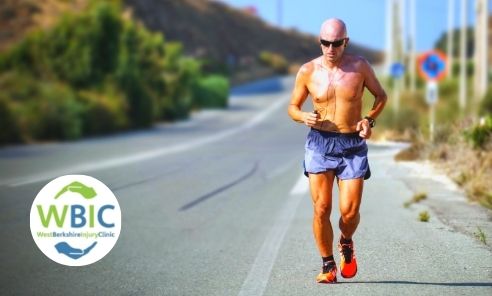If you are training recreationally or for non-competitive reasons, it is probably a good idea to avoid training the heat and plan train in the cooler times of the day if possible.
That’s what I generally do! There you go, end of blog… Oh OK, I’ll continue…
If you find you are exercising or competing in the heat, make sure you take precautions. Hydration before, during and after the training may sound obvious but it is extremely important. Also, to guard against the sun’s rays, wearing protective clothing, or using sweat resistant sunblock. If you can, choose a route with shade or where you can take a breather in shade. Or even loops near your home, so you can get back quickly if in discomfort.
If competing over long hours take it a bit easier if you’re not used to the heat. There are cooling towels or other things you can use if you have rest periods to help cool you between exercise bouts or matches if at a tournament. A simple way to check hydration is a urine chart that will give you a rough idea of how hydrated you are. You can also weigh yourself before and after to see how much fluid needs replacing (1 litre=1Kg).
Listen To Your Body When You Are Training In The Heat
If you feel thirsty, it’s a simple indicator you may be a little dehydrated and should have a drink. Keep checking yourself and if you have symptoms like:-
- a headache,
- nausea,
- dizziness and
- excessive tiredness,
Then reduce your intensity or stop all together, and drink. This will reduce the chances of heat illness, heat stroke or heat exhaustion kicking in. The simplest way to cool down is to reduce how hard your body is working. Once you have cooled a bit or had some fluids, you may find you can up the intensity a bit. Once back at base, you can splash with cool water or put your body, legs or feet in cold water to aid cooling.
[Read more about the importance of hydration in our new blog – How To Avoid Dehydration And Cramp]
Heat will sap your energy more than temperate climates, so also ensure you are adequately nourished before, during, and after also. So sometimes a fizzy or energy drink is a good idea along with water after your exertions.
Training In The Heat Can Have Benefits
Altitude training can increase oxygen-carrying capacity, enhance efficient use of oxygen, and improve the ability to tolerate anaerobic metabolism. Heat training has the ability to increase plasma volume and reduce cardiovascular and thermoregulatory strain. It is recommended to focus on the most relevant intervention to your competition and ensure that training, nutrition, and recovery are optimized for positive training adaptations and, ultimately, enhance performance.
Training in the heat, especially for sports with a high endurance requirement, has been shown to improve performance when back at temperate climates (5°C–18°C) at sea level. So similar to altitude training, can be useful in enhancing aerobic capacity and power by up to 5%. Again, there are different methods, but the main thing is to ease into this in the early stages. You can cheaply simulate basic heat acclimatisation by wearing more clothes training at home or at hot times outdoors, and this is what I did before competing at the Touch World Cup in Malaysia. Heat training, although deemed less effective than altitude training, may therefore be a useful adjunct to athletes without the funding or access to altitude training facilities or equipment. It gets more technical if you need to train for certain temperature and humidity ranges.
Similar to altitude training, the body will adjust relatively quickly over 1-2 weeks of heat training with most improvement in week 1. The benefit is lost slower than the gain, so one method you can use is to acclimatise several weeks before travel or competing in the heat, do a few more weeks normal training or tapering, then travel and spend a week acclimatising before competing. There are several methods you can use prior to competing, and the chosen method will depend on individual circumstances. And have a trial run beforehand if possible so you get it right when it matters.
After all that hard work, have a good recovery and enjoy the sun with a cool drink in the shade.
If you need more specific advice on the above, please get in contact to see how we can help. Contact Us


